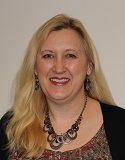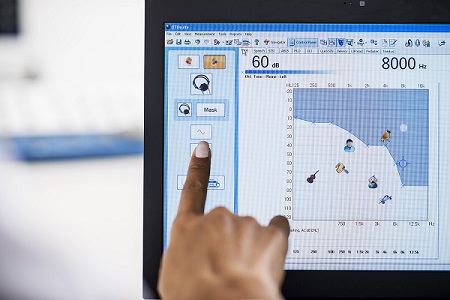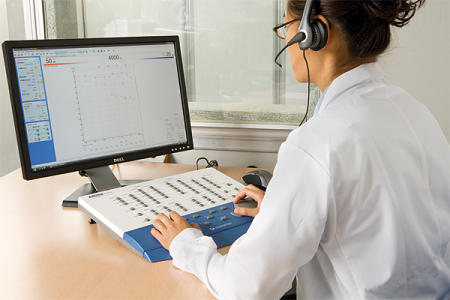Astera² PC-Based Clinical Audiometer, and Customer Care at Otometrics
Carolyn Smaka: Welcome Kathleen and Keeley! It has been a busy year for Otometrics.

Keeley Moore: Yes, 2013 has been a great year for Otometrics and Audiology Systems - from product innovations to delivering a new level of customer care. Our expanded product portfolio now includes the new MADSEN Capella2 OAE solution and the ICS Impulse Video Head Impulse Test (vHIT), which were released earlier this year. Recently, we also introduced the MADSEN Astera2 PC-based audiometer.
Carolyn: We learned about the Impulse in our last interview back in April. Tell me about the new Astera2.
Keeley: Otometrics was first to the market with a computer-based audiometer, the Astera, which has quickly become the clinical standard. We have built on that legacy and added more features and tools with the new Astera2. For existing Astera users, it’s like they getting a new audiometer through a simple software upgrade.
Carolyn: Would you give an overview of the new features?
Keeley: I’d be happy to. With Astera2, the updates are primarily software-based, which opens up a lot of new possibilities.
We have a new tinnitus assessment tool, where we have taken key tinnitus test batteries and put them all in one place under one tab. We have also included the most commonly used tinnitus questionnaires so that you can do pre- and post-treatment measures conveniently as part of the software. And if you use NOAH, these become part of the NOAH file for the patient.
With all the new hearing instruments with integrated tinnitus management on the market, more audiologists may be interested in working with tinnitus patients. Now, we have made it easier and more time-efficient to conduct some of the important tinnitus diagnostic and treatment measures.
Carolyn: That’s great. What other new features does the Astera2 have?
Keeley: We also have a new pediatric module, which is an add-on to the Astera2 and OTOsuiteTM. This allows you to test children in a very efficient manner.

The Sunshine™ control panel is an intelligent touch screen interface.
We have what we call the new Sunshine™ panel that allows you to test the child while you are in the booth. I think it is ideal for practices that don’t have the benefit of having a second tester with a child. You can go into the booth, and from the touchscreen, test the patient like you normally would. This is a touchscreen-friendly interface so that you are not struggling with trying to press the right place on the touchscreen. The buttons are really big so that you can quickly and easily get to where you want as you are testing the child. This combined with integrated control of visual reinforcers allows the clinician to easily perform VRA from the touchscreen. You can sit with the child with the touchscreen in front of you where they cannot see it, and perform a complete audiometric test battery. You can also track questionable responses on screen (as opposed to using scratch paper).
I think that is very valuable, considering to how you would have to perform testing in the booth without this tool. You typically would have to get the portable audiometer, an audiogram, a pen, and try to balance all this and position yourself so that the child cannot see you presenting the tones. You are also simultaneously trying to engage the child and maintain his or her attention. It is very complicated and very stressful. Now with the touchscreen, you can sit and interact one-on-one with the child, and use the same audiometer you are used to using for all your testing. The child is not intimidated or distracted by all this other stuff in the booth. I’m sure many clinicians have had the experience with some children where you have their attention while you are in the booth, and as soon as you leave to go to the audiometer on the other side of the window, you lose their attention as you are in a different room. Or, once you set them up and leave the test room, they pull out the insert earphones. This tool makes pediatric testing much more efficient and less stressful.
Carolyn: Tell me about LIPread™.
Keeley: As you know, many professionals perform speech audiometry with and without visual cues to assess real world listening skills. The aim of the lip reading speech test is to enhance the ability to estimate real-world listening skills and to predict benefit from amplification including cochlear implantation.
The lip reading test module became available as an option in a recent release of Astera2.
It’s simple to use offering a clear overview of the speech sentences on the primary screen and a floating window with video of the talkers on the secondary screen. Since you can store the results, you can accurately track progress. The measurements allow you to assess habilitation/rehabilitation progress and guide clinical intervention.
Carolyn: You mentioned that since Astera2 is software-based, it opens up a lot of opportunities. Can you expand on that?

The Madsen Astera2 PC-Based Clinical Audiometer.
Keeley: Sure. With software-based updates, you can expand the functionality and features of the Astera2 in the future. It provides a level of flexibility that you don’t have with other audiometers. As new tests and new protocols are developed, we can respond to our customers’ needs and integrate these into Astera2.
We can deliver new features with a simple software update. The clinician can simply upload them, or do it with the help of our regional Audiology Systems representatives. They do not necessarily have to invest in a whole new audiometer. Up until we had pc-based audiometry, the audiometer you bought on day 1 is the same audiometer 10 years later when you take it out of service. It never changed. With Astera2, as the field changes and grows, we can respond by implementing the tools you need via a software update. The audiometer you buy today will be an even better audiometer in a few years.

Kathleen Hill: We hear from our customers that capital expenditure requests are nearly impossible to get approved today. It is incredibly difficult in most settings to purchase new equipment and tools. With Astera2, in order to get a new feature, all you have to do is get a software upgrade. Hospital administration or even a small private practice is more likely to get these upgrades rather than buy a whole new piece of hardware.
As audiologists, we are used to thinking we have to spend $5,000, $10,000, or $20,000, for new equipment with new features. Astera2 can expand almost exponentially with just simple software upgrades that are significantly less expensive. That is really exciting because you can now keep up with the times and not feel that you are behind because you cannot afford to buy an expensive new piece of hardware.
Keeley: Some people may be intimidated by the term PC-audiometry. However, everything you do on your non-PC audiometer via buttons and your knobs, you can do with the Astera. It combines the best of both worlds. In fact, we have an audiometer control panel that looks and functions exactly like a traditional audiometer that you may have been trained on. The nice part about the Astera and OTOsuite is that you can make it function however you like. You can do everything with the audiometer control panel, or do everything with the mouse, or do everything with the keyboard or go between them. It is extremely flexible, and allows us to still have that traditional audiometer-type set-up that many of us are comfortable with.
You are also able to set up OTOsuite for each individual clinician in the same clinic. Traditionally, this can be a source of conflict in a practice because audiologists may set up their audiometers in different ways, and they do not want to have to change everything around every time they begin testing. With OTOsuite, you can set preferences for each audiologist, and with a click of a button the audiometer will begin at your settings. And, you can set up special situations such as a test protocol for an early intervention child versus a protocol for school-aged child or an adult. It is very flexible in that you do not have to reinvent the wheel every time you sit down at the audiometer.
Kathleen: In addition, since this is a PC-based system, it will easily integrate into your electronic medical records (EMR). As everything is moving over to EMR, you eliminate the human error of having to transfer written records into an electronic mode.
Overview of Astera2.
Carolyn: Tell me about "The Cube" and how it may affect customer care for clinicians. If I am a customer who has your equipment, how will I see that change in my day-to-day interactions with Otometrics?
Kathleen: Yes, together with our exclusive distributors, we are taking customer care to a new level. Since August 2012, Otometrics brands - AURICAL, MADSEN and ICS - were offered exclusively through Audiology Systems and partners. Your local team consists of specialists in Otometrics equipment and are backed by a national customer support network for your audiology, technology, instrumentation and service needs. For more information, view our Video Spotlight on customer care.
For instance, if you purchase any of our equipment or currently have our equipment, we have audiologists available to provide support through Audiology Systems. Whether you want to walk through a protocol or have a an accessory question, they can help.
In addition to telephone support, they can even log into your computer to assist with a setup, or to answer a question when you have a patient in front of you. It is almost like having the audiologist right in your office showing you how to do things. They can often assist remotely, as opposed to having to literally fly someone out there and take up your time.
Keeley: I think it’s important to note that in light of all the support that Audiology Systems provides, Astera2 and OTOsuiteTM are intuitive and flexible so that most people sit down and work their way through without a lot of instruction. Typically, people will call after they have been using their equipment for a couple of weeks, and they’re ready to learn more about all the various features.
Kathleen: From an education standpoint, we have instructional videos available online and provide in-house training so they can help you see exactly how to do something that you need to do. We also offer courses nationwide like the FittingNOW! series and the Video Head Impulse Test (vHIT) series offered in key cities nationwide, along with the comprehensive 3-day VNG course in Chicago in May and October of each year.
“The Cube” is a clinically-focused education and training platform. It consists of an e-Learning module, reference materials, as well as onsite training at our IQ Lab in Schaumburg, Illinois. We have gathered all that we know within audiology and technology for hearing assessment, fitting, balance and screening solutions and made it more accessible by to our sales and service team via our online courses, videos and much, much more. For more info, view our Video Spotlight on The Cube.
Keeley: Our new customer-focused approach is to create a partnership with our customers. And we are there to support you throughout the whole process – from consultative dialogue, to installation and service, to education and training. Your local team is much more educated on Otometrics products and on what audiologists want. They are looking to meet your needs for your clinic. They don’t just drop off your new equipment. They are really interested in showing you how to maximize the equipment that you have. They also want to help you look to the future to grow your business and prepare for what you may need tomorrow. It’s a consultative approach, rather than a sales approach.
Carolyn: Thanks for all the information today, it has been great speaking with you both. For more information about Otometrics and their product offerings, please visit: www.otometrics.com or the Otometrics Expo Page on AudiologyOnline.

